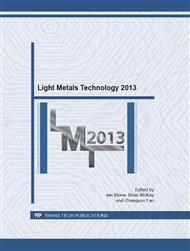p.326
p.331
p.336
p.343
p.348
p.353
p.358
p.363
p.368
Characterizing the Asymmetric/Anisotropic Deformation Response and Forming Behaviour of Wrought Magnesium and Titanium Alloys
Abstract:
There is the requirement to describe the asymmetric and anisotropic deformation behaviour of hexagonal closed packed (hcp) alloys, including wrought magnesium and titanium. Magnesium and to limited extent, titanium, alloys are candidate materials for weight and emission reduction in the automotive industry. Predicting the deformation response of hcp alloys is challenging to the complexity and number of potentially operative deformation mechanisms which can drastically change with temperature, deformation rate, and chemistry. In this work, the constitutive material response is described using various asymmetric/anisotropic yield criteria, specifically designed to describe the deformation response of hexagonal close packed (hcp) materials. These models allow the size and shape of the yield surface to evolve with plastic strain. The Marciniak-Kuczynski (M-K) approach is utilized to predict the forming limit in the form of forming limit diagrams (FLD). The degree of asymmetry and anisotropy is varied in the predictions to quantify their effects on the forming limit response. The numerical FLD predictions are compared to FLD which have been experimentally determined for AZ31B magnesium and Grade 1 CP titanium sheet alloys. For CP titanium alloys, it was found that it was important to capture the asymmetry and anisotropy of deformation to capture the forming limit response. For AZ31B formed at 200 °C, it was important to capture the strain-rate sensitivity of the material, more so than the asymmetry and anisotropy of deformation, for predicting the forming limit behaviour. The combination of experimental data and predictive models developed in this work are intended to characterize the forming behaviour of various lightweight sheet alloys without the requirement for excessive experimental data, and to ultimately aid in the selection of lightweight sheet metals for multi-material vehicle design.
Info:
Periodical:
Pages:
348-352
Citation:
Online since:
July 2013
Authors:
Keywords:
Price:
Сopyright:
© 2013 Trans Tech Publications Ltd. All Rights Reserved
Share:
Citation:


